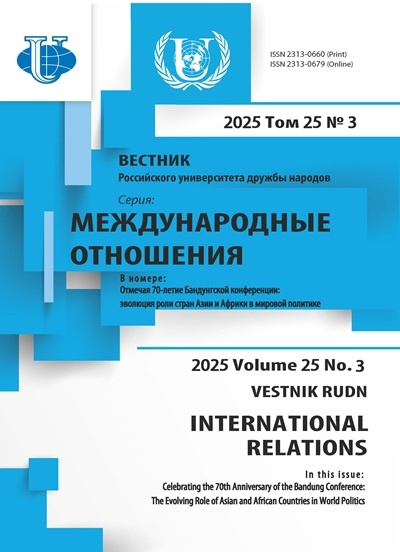Роль резолюции A/RES/S-30/1 в формировании новых подходов ООН к противодействию незаконному обороту наркотиков на глобальном уровне
- Авторы: Еремин А.А.1, Еремина М.С.1, Абдурашитова Э.А.1
-
Учреждения:
- Российский университет дружбы народов
- Выпуск: Том 17, № 1 (2017): Международные организации и незападный мир
- Страницы: 95-110
- Раздел: МИР И БЕЗОПАСНОСТЬ
- URL: https://journals.rudn.ru/international-relations/article/view/15880
- DOI: https://doi.org/10.22363/2313-0660-2017-17-1-95-110
- ID: 15880
Цитировать
Полный текст
Аннотация
Статья рассматривает роль и влияние резолюции Генеральной ассамблеи ООН A/RES/S-30/1 «Наша общая приверженность эффективному решению мировой проблемы наркотиков и борьбе с ней» на современное состояние общемировых усилий по борьбе с глобальной проблемой наркотиков и формирование тенденции противодействия наркотрафику. Показано развитие тенденции к поиску сбалансированных подходов формирования антинаркотической политики на национальном, региональном и глобальных уровнях, которая находит свое проявление в уходе от стандартных практик силового воздействия, характерных для концепции «Войны с наркотиками», в сторону ориентированных на человеколюбие и гуманизм альтернатив. В заключительной части статьи делается вывод о существовании консенсуса среди отдельных развитых и развивающихся стран различных регионов относительно необходимости разработки и внедрения новых решений для глобальной проблемы наркотиков. Авторы приходят к выводу, что все больше внимания в рамках международного сообщества уделяется социальной составляющей проблемы наркотиков, подразумевающей разработку и внедрение альтернативных судов и исправительных учреждений, стимулирование социально-экономического развития, мер по декриминализации и в отдельных случаях легализации.
Об авторах
Аркадий Алексеевич Еремин
Российский университет дружбы народов
Автор, ответственный за переписку.
Email: 79151775018@yandex.ru
Москва, Россия
Мария Сергеевна Еремина
Российский университет дружбы народов
Email: mariya.eremina1@ru.neste.com
Москва, Россия
Эльнура Абдурашитовна Абдурашитова
Российский университет дружбы народов
Email: elnura.sv@mail.ru
Москва, Россия
Список литературы
- Потемкина О.Ю. Наркотрафик - угроза международной безопасности // Россия и Европа: невоенные аспекты безопасности. Институт Европы РАН. М.; 2009. С. 170-198
- Серова Е.С. Конфликтогенные аспекты взаимосвязи проблем экстремизма и наркотиков // Конфликтология. Т. 2. СПБ.; 2016. С. 293-298
- Степанова Е.С. Транснациональные угрозы: терроризм, наркотрафик, пиратство // Россия в полицентричном мире. ИМЭМО; 2011. С. 141-148
- Cardesa-Salzmann A. Transnational Environmental Crime and the Resilience of International Law: Shaping Illegality in Multilateral Environmental Agreements. In: Joint International Environmental Law - International Legal Theory Interest Group Meeting: The Resilience of Law, European Society of International Law. Latvia, Riga; 2016
- Latest F., Fryklund I. On Drugs and Democracy. In: Foreign Policy in Focus. 2012
- Matlin S.A., Told M., Tinasti N. Time to Revisit Drug Policies: Towards the UNGA Special Session on Drugs. Graduate Institute of International and Development Studies, Geneva; 2014
- McCollum B. Threat Posed by the Convergence of Organized Crime, Drug Trafficking, and Terrorism. Darby: Diane publishing; 2002
- Ritter A. Methods for comparing drug policies - The utility of composite Drug Harm Indexes // The International Journal on Drug Policy. 2009. Vol. 20. N 6. P. 475-479.·
- Rhodes T. «The risk environment»: a framework for understanding and reducing drug-related harm // The International Journal of Drug Policy. 2002. Vol. 2. Is. 13. P. 85-94
- Rhodes T. Risk environments and drug harms: A social science for harm reduction approach // International Journal of Drug Policy. 2009. Vol. 20. Is. 3. P. 193-201
- Ruiz A.R., Correa L.H., Leon D.O., Williams S. Coca Cultivation and Crop Eradication in Colombia: the Challenges of Integrating Rural Reality into Effective Anti-drug Policy // The International Journal of Drug Policy. 2016. N 33. P. 56-65
- Sandvik K.B., Hoelscher K. The Reframing of the War on Drugs as a “Humanitarian Crisis”: Costs, Benefits, and Consequences // Latin American Perspectives. 2016. Vol. 20. N 30. P. 1-15
- Saenz E., Busse A., Tomas J., Clark N. Major International Challenges in Addiction Treatment: The Experience of TreatNet and Beyond. In: el-Guebaly N., Carrà G., Galanter M. editors. Textbook of Addiction Treatment: International Perspectives. Springer; 2015. p. 2459-2471
- Unlu A., Kapti A. Failed alternative development programs: An implementation analysis of coca supply-reduction programs in Bolivia // International Journal of Public Policy. 2012. Vol. 8. N 1, 2, 3. P. 160-179
- Umpierrez E., Chung H., Iversen L., Ifeagwu S. Terminology and Information on Drugs. United Nations Publication. UNDOC; 2016
Дополнительные файлы










